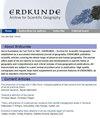挥舞地图以显示国家身份:在18和19世纪,挪威和瑞典的制图学是如何被用作国家建设工具的
IF 1.1
4区 社会学
Q3 GEOGRAPHY
引用次数: 0
摘要
几个世纪以来,制图一直被用作支持民族自豪感、影响力和影响力的政治工具,无论是通过使用国家本初子午线还是当地地名,通过颜色强调国家的范围,还是通过投影强调甚至扭曲其位置和大小。在斯堪的纳维亚半岛,十八世纪和十九世纪是动荡时期,在此期间,各地区改变了政治派别,各国形成了不断变化的政治联盟。自1380年以来,挪威一直不是一个独立的国家,但到了19世纪之交,挪威的民族意识正在兴起,与此同时,欧洲其他地区对民族国家的观念也在兴起。本文的目的是研究在与丹麦联盟的最后几十年(1380-1814)和1814年与瑞典新联盟的头几十年(-1905),挪威对民族认同的日益关注是否以及如何通过制图培养起来。另一个目的是考虑瑞典作为工会的高级合作伙伴,如何同样利用地图绘制来保持工会的团结,以反对挪威的民族自决。对18世纪末和整个19世纪的斯堪的纳维亚地图进行了分析,重点是对国家认同有潜在影响的制图元素。主要结果表明,当时的挪威和瑞典地图都可能被用作政治影响力的工具。在所分析的地图上使用制图元素似乎一方面加强了瑞典的霸权,另一方面又加强了挪威的民族主义,从而加强了今天仍然存在的斯堪的纳维亚的政治分裂。本文章由计算机程序翻译,如有差异,请以英文原文为准。
Waving the map for national identity: How cartography in Norway and Sweden was used as a nation-building tool in the eighteenth and nineteenth centuries
Cartography has for centuries been used as a political instrument to support national pride, impact and influence, whether through use of a national prime meridian or local toponyms, the emphasising of the country’s extent through colour, or the underlining and even distorting of its position and size through projection. In Scandinavia, the eighteenth and nineteenth centuries were times of upheaval, during which regions changed political affiliation and nations formed shifting political unions. Norway had not been an independent nation since 1380, but by the turn of the nineteenth century, Norwegian national consciousness was emerging, in parallel with the rise of ideas about the national state in the rest of Europe. The purpose of this paper is to examine whether and how the rising focus on national identity in Norway was nurtured through cartography during the final decades of the union with Denmark (1380-1814) and the first decades of the new union with Sweden from 1814 (-1905). A further aim has been to consider how Sweden, as the senior union partner, might similarly have used cartography to keep the union together as a unity, in opposition to the Norwegian national self-assertion. A selection of Scandinavian maps from the late eighteenth century and throughout the nineteenth century have been analysed with a focus on cartographic elements with potential impact on national identity. The main results indicate that both Norwegian and Swedish maps of that time may have been used as instruments of political influence. The use of cartographic elements on the analysed maps in general seem to have strengthened Swedish hegemony on one side and Norwegian nationalism on the other side, thus reinforcing the political division of Scandinavia still seen today.
求助全文
通过发布文献求助,成功后即可免费获取论文全文。
去求助
来源期刊

Erdkunde
地学-自然地理
CiteScore
2.00
自引率
7.10%
发文量
17
审稿时长
>12 weeks
期刊介绍:
Since foundation by Carl Troll in 1947, ''ERDKUNDE – Archive for Scientific Geography'' has established as a successful international journal of geography. ERDKUNDE publishes scientific articles covering the whole range of physical and human geography. The journal offers state of the art reports on recent trends and developments in specific fields of geography and comprehensive and critical reviews of new geographical publications. All manuscripts are subject to a peer-review procedure prior to publication. High quality cartography and regular large sized supplements are prominent features of ERDKUNDE, as well as standard coloured figures.
 求助内容:
求助内容: 应助结果提醒方式:
应助结果提醒方式:


